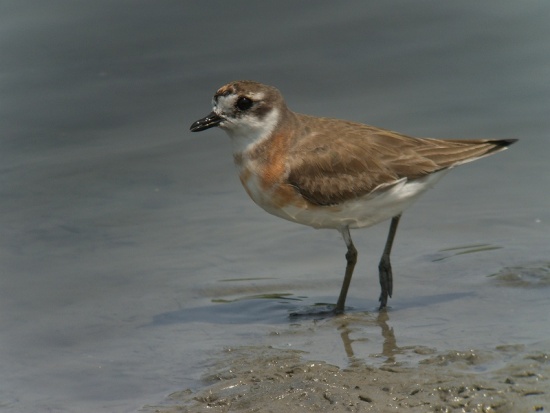| Line 1: | Line 1: | ||
| − | ;Charadrius mongolus | + | ;[[:Category:Charadrius|Charadrius]] mongolus |
| − | [[Image:Mongolian_Plover.jpg|thumb|550px|right|Photo by Akiko Hidaka <br/> Photo taken: Tokyo Japan]] | + | [[Image:Mongolian_Plover.jpg|thumb|550px|right|Photo by Akiko Hidaka <br/>Photo taken: Tokyo, [[Japan]]]] |
| + | Aka '''Lesser Sand Plover''' | ||
==Identification== | ==Identification== | ||
| − | + | Grey backs and white underparts. Chestnut breast, forehead and nape, black eye mask. The female is duller, and winter and juvenile birds lack the chestnut. Legs are dark and the bill black. | |
| − | Grey backs and white underparts. Chestnut breast, forehead and nape, | ||
==Distribution== | ==Distribution== | ||
| Line 10: | Line 10: | ||
==Taxonomy== | ==Taxonomy== | ||
| − | There are five races, and the large east Asian forms, C. m. mongolus and C. m. stegmanni, are sometimes given specific status as Mongolian Plover, Charadrius mongolus. If the taxonomic split is accepted, Lesser Sandplover as then defined becomes Charadrius atrifrons, including the three races atrifrons, pamirensis and schaeferi. | + | There are five races, and the large east Asian forms, ''C. m. mongolus'' and ''C. m. stegmanni'', are sometimes given specific status as Mongolian Plover, ''Charadrius mongolus''. If the taxonomic split is accepted, Lesser Sandplover as then defined becomes ''Charadrius atrifrons'', including the three races ''atrifrons'', ''pamirensis'' and ''schaeferi''. |
==Habitat== | ==Habitat== | ||
| Line 19: | Line 19: | ||
The flight call is a hard trill. | The flight call is a hard trill. | ||
| − | |||
| − | |||
==External Links== | ==External Links== | ||
{{GSearch|Charadrius+mongolus}} | {{GSearch|Charadrius+mongolus}} | ||
*[http://www.aviceda.org/abid/birdimages.php?action=birdspecies&fid=39&bid=503 View more images of this species on the ABID] | *[http://www.aviceda.org/abid/birdimages.php?action=birdspecies&fid=39&bid=503 View more images of this species on the ABID] | ||
*[http://www.orientalbirdimages.org/birdimages.php?action=birdspecies&Bird_ID=1021&Bird_Image_ID=376&Bird_Family_ID=109 View more images of this species on Orientalbirdimages] | *[http://www.orientalbirdimages.org/birdimages.php?action=birdspecies&Bird_ID=1021&Bird_Image_ID=376&Bird_Family_ID=109 View more images of this species on Orientalbirdimages] | ||
| − | [[Category:Birds]] | + | [[Category:Birds]] [[Category:Charadrius]] |
Revision as of 12:09, 19 June 2008
- Charadrius mongolus
Aka Lesser Sand Plover
Identification
Grey backs and white underparts. Chestnut breast, forehead and nape, black eye mask. The female is duller, and winter and juvenile birds lack the chestnut. Legs are dark and the bill black.
Distribution
Taxonomy
There are five races, and the large east Asian forms, C. m. mongolus and C. m. stegmanni, are sometimes given specific status as Mongolian Plover, Charadrius mongolus. If the taxonomic split is accepted, Lesser Sandplover as then defined becomes Charadrius atrifrons, including the three races atrifrons, pamirensis and schaeferi.
Habitat
Behaviour
It nests in a bare ground scrape, laying 3 eggs.
Diet includes insects, crustaceans and annelid worms.
The flight call is a hard trill.




